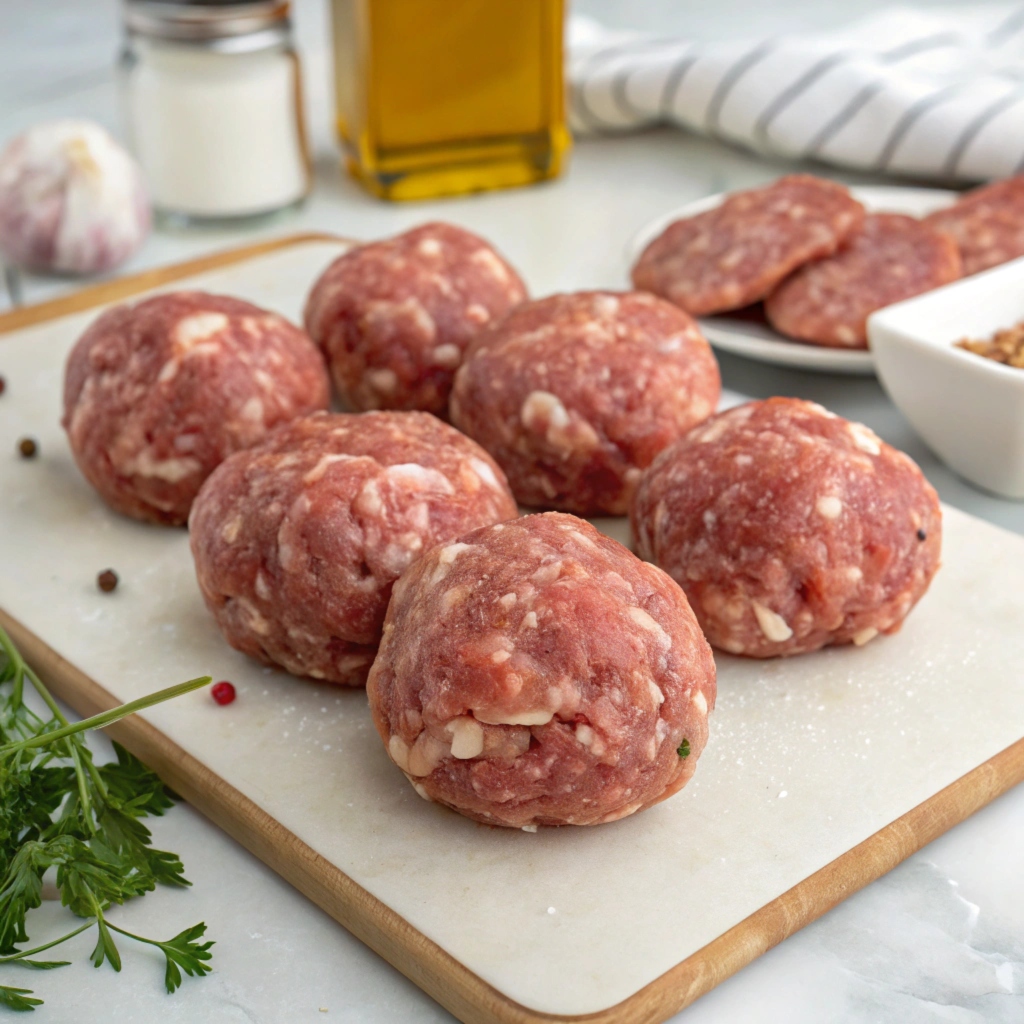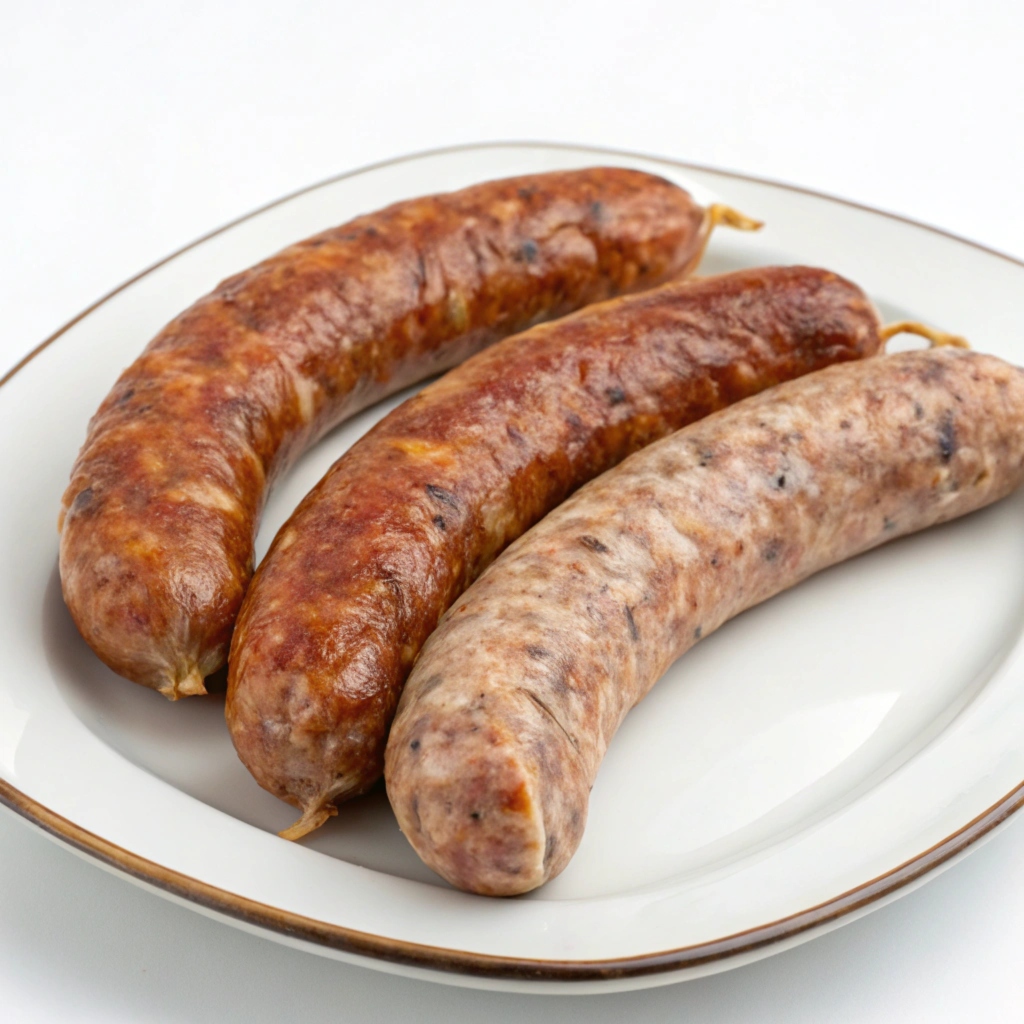Introduction
Sausages are an extremely popular dish worldwide, yet many people struggle with dryness when preparing them. The problem “Why do my sausages seem so dry? “ usually arises because getting the right balance between flavours and moisture isn’t easy. Various factors can contribute to this issue, from the selection of ingredients to the cooking methods. This article explains the intricacies of making sausages and will help you make delicious sausages each time.
Table of Contents
Understanding Sausage Texture: A Brief Overview
Sausage texture plays an integral part in the overall appeal. If you’re thinking “Why do my sausages seem so dry?” The reason is mainly in the science behind the composition of meat and fat. Sausages depend on the ideal fat ratio to meat to ensure their savoriness. Fat is a source of moisture and taste, while lean meat provides for the overall structure.
If the fat is too tiny, Sausage dries out fast when cooked. Additionally, the protein structure of the meat shrinks when exposed to temperatures and squeezes out the moisture. Knowing this is essential to avoid dryness. Another reason is the binding agents used for this purpose, like rusk or breadcrumbs, which hold in moisture and prevent sausages from becoming brittle.
Its main takeaway: Maintaining a delicate equilibrium of protein, fat and binders is crucial to get that desired appearance.
The Role of Ingredients in Sausage Quality

The selection of the ingredients is a crucial factor in making your sausages. If you’ve ever asked yourself, “Why do my sausages seem so dry?” The answer could be in the ingredients that you’re using – or not making use of. Good quality meat with a nice marbling of fat can be the foundation of tasty sausages as the fat melts in the cooking process and aids in keeping moisture. Without enough fat, your meat can dry out, rendering the sausages hard and unappetizing. Additionally, although the seasonings and spice blends are vital to flavour, they do not directly impact the quality of the Sausage. Therefore, it’s crucial to get the main ingredients perfect.
The most important considerations for the key ingredient:
- Content of fat: Sausage relies on an inverse ratio of fat-to-lean between 20-30% fat for maximum texture and retention of moisture. Fat doesn’t just keep the sausages moist, but it can also improve their taste and taste. Even the best seasonings won’t stop dryness if fat levels are insufficient.
- Filters and Binders: Oats breadcrumbs, breadcrumbs and powdered milk are crucial to retaining moisture. They function as sponges to absorb the liquids present in the Sausage and gradually release them during cooking. By omitting these components, you could cause a dry, crumbly dry, dry texture.
- Liquids added: Adding a small amount of chilled water, broth, or milk to the dish helps keep the meat moist and pliable. The extra moisture helps prevent the proteins present in the meat from tightening up too significantly while cooking and can make juices difficult to squeeze out.
Your Sausage’s quality begins at the source of your meat. Make sure to select fresh cuts that have apparent marbling. Generally, pre-ground or meat that is excessively lean often isn’t able to make delicious sausages. Try grinding the meat by hand to manage the texture and to ensure an even fat-to-lean ratio. Also, playing around with various fillers and binders can enhance the structure and retention of moisture in your sausages. For example, breadcrumbs in milk will help hydrate the mix and give it a soft bite.
Do not cut corners or skimp on essential ingredients since these decisions directly affect your final products. Insufficient fat, subpar meat, or lack of liquids or binders can produce dry and unappetizing sausages. If you focus on premium balanced ingredients, you can make meats with a moist, delicious and satiating consistency.
Importance of Proper Cooking Techniques to Avoid Dry Sausages
The correct cooking methods are essential in solving the issue of “Why do my sausages seem so dry?”. Grilling pan-frying, and baking affect moisture retention differently. The method of cooking sausages determines the juiciness and texture of their sausages.
Overcooking is one of the significant causes of dryness. To prevent this from happening, you should use a thermometer to determine the internal temperature. It is expected to be at 160degF (71degC) for meat or pork sausages and 160degF (74degC) for poultry sausages. Slow and low cooking techniques are preferred to preserve moisture, whereas high heat will quickly dry the sausages and the meat.
Essential Tips for Cooking Sausages Perfectly:
- Do not touch the casing too much because this can release valuable juices.
- Make use of medium heat to cook evenly without drying the exterior.
- Let the sausages rest after cooking so that juices can be distributed.
Learning the correct cooking methods will ensure your sausages stay soft and delicious.
The importance of temperature and time to prevent sausages from drying out

If you’ve ever thought, “Why do my sausages seem so dry?” The culprits are usually temperatures and timing. Both impact the degree to which sausages are soft and moist or dry and bland. Excessive cooking temperatures can cause the protein inside the meat to expand excessively, releasing the natural juices and making dried meat. In the same way, letting sausages cook on the stove for too long can result in cooking too long, further aggravating the dryness problem.
Key Aspects to Monitor for Juicy Sausages:
- The internal temperature of the Sausage: Always use a meat thermometer to ensure that the food is cooked precisely. The ideal temperature for internal Sausage is 160degF (71degC) for beef or pork, and the temperature should be 165degF (74degC) for poultry. If you exceed these temperatures, you risk getting rid of the moisture, even for high-fat sausages.
- Time to cook: Avoid guessing cooking times by setting timers and checking the sausages regularly. This will prevent excessive exposure to heat, which could cause them to dry out in excess.
Slowly cooking sausages at a controlled temperature is the best method to preserve their freshness and taste. When baking, setting the oven temperature to 350 degrees F (175 degrees C) and then cooking for 20-25 minutes will ensure even heat distribution and allow the sausages to cook evenly and not dry out. When pan-frying or grilling, it is essential to turn the sausages frequently. The turning of the sausages can prevent them from burning unevenly and burning. This could cause damage to the casing and permit the juices to leak out.
For more control, consider using a slow and low method, such as simmering the sausages in broth or water before transfer to a skillet or grill. This will help cook the sausages slowly and also seal in the moisture. After they’ve been cooked, place them on the grill or pan and grill them for a few minutes at an appropriate temperature to achieve an attractive golden brown exterior without losing the delicious meat inside.
Balancing temperature and cooking time ensures that your sausages are succulent, tasty and perfectly cooked each time. These simple adjustments transform an otherwise dry dish into a delicious culinary hit.
The effect of the casing selection on the degree of humidity required to avoid dryness of the sausage

The casing plays an essential part in the quality of sausages, directly impacting the issue of “Why do my sausages seem so dry?”. Natural casings from animal intestines are more permeable and flexible than synthetic ones. They contract and expand along with the Sausage, assisting in keeping juices in.
On the contrary, artificial casings can be less effective in conserving moisture. If the casing has not been properly prepared or soaked for cooking, it may result in a dry texture. Furthermore, improper handling, such as under-soaking or overstuffing, can cause casings to break or shrink when cooking.
Why Do My Sausages Seem So Dry? Tips for Preparing Casings Properly:
- Natural casings should be soaked in water for 30 minutes before use.
- Be careful not to overfill casings to prevent them from bursting.
- Choose the highest-quality casings for the best outcomes.
Knowing the type of casing you choose and how it is prepared can greatly improve the texture and flavour of your sausages.
It is the Importance of Meat Quality to ensure that sausages don’t dry out.

The meat quality will determine the outcome of your sausages, whether dry or moist. If you are thinking “Why do my sausages seem so dry?” Consider the freshness of your meat, its fat content and marbling. Fresh, well-marbled meat retains moisture during cooking, leading to the tenderness of the Sausage.
Grinding meat at home lets you control the texture and consistency while ensuring the proper proportion between fat and lean. If you purchase ground meat in a bag, look at the label to determine the fat content. Pre-ground ground meat usually has less fat than is appropriate for sausages, leading to dryness.
Why Do My Sausages Seem So Dry? Tips for Choosing the Right Meat:
- Select cuts with greater fat content, like meat shoulder, pork and beef Chuck.
- Make sure to grind meat fresh to ensure more control over the moisture levels.
- Beware of lean-only products, as they do not have enough fat to ensure juiciness.
You can make flavorful and delicious sausages with the right selection of meat.
Addressing Dryness in Sausages: Effective Tips for Retaining Moisture
If you’re constantly asking , “Why do my sausages seem so dry?” Knowing how to hold moisture throughout preparation is essential. Moisture retention begins during mixing and goes until the time of cooking. Ensure you add the appropriate quantity of fat and liquid to your sausage mixture to ensure it remains juicy.
Practical Techniques for Retaining Moisture in Sausages
- Mix in ice-cold cold water to ensure the meat is not overheated.
- Mix ingredients well without overworking the mix.
- Use binders such as milk powder or breadcrumbs to hold in moisture.
- Let the sausages rest before cooking, allowing the ingredients to get settled.
Properly hydrating the mix and careful handling will go a long way in ensuring that the sausages are succulent. Avoid shortcuts that can compromise texture. Also, remember that the small details often create the biggest impact.
Understanding Regional Variations in Sausage Recipes
The query “Why do my sausages seem so dry?” could be traced to the origins of the recipe. Different regions of the world are different in their approach to making sausages, and each has its particular texture and moisture pattern.
For example:
- German sausages, like bratwurst, contain eggs or cream for an extra-rich texture.
- Asian Sausage may contain sugar or soy sauce, which helps retain moisture during cooking.
Understanding these differences can lead to recipes that align with your preferred texture. Doing experiments with regional recipes lets you take advantage of sausages with unique flavours while ensuring they’re fresh and tasty.
Preventing Dryness in Sausages: Proper Storage and Reheating Techniques
The methods used to store and heat your sausages will significantly affect the degree to which your sausages stay dry or moist. If you’ve ever considered “Why do my sausages seem so dry?” when you’ve reheated leftovers, it could be due to handling errors.
Storage tips:
- Cooked sausages can be stored inside an airtight container to stop drying out.
- The raw sausages are wrapped tightly in plastic or vacuum-sealed bags to keep freshness.
- To avoid freezer burn, properly seal sausages before freezing.
Reheating techniques:
- Utilize moderate heat, for example, heating or steaming in sauces, to replenish the moisture.
- Avoid microwaving with high power as it could draw out juices.
- Include an extra splash of broth or water while cooking to help rehydrate your meat.
Following these steps, you can retain the flavour and the texture regardless of how long they’ve been stored.
Troubleshooting Dry Sausages: Quick Fixes
If you’ve prepared your sausages but are left wondering, “Why do my sausages seem so dry?” There are options to save them. Prevention is always the best quick fix that can enhance the texture and taste of dry sausages.
Dry sausage solutions:
- Serve them with gravies or sauces to provide moisture and increase the flavour.
- Slice the sausages, and then mix them into stews or soups.
- Use oil or butter before reheating to bring back some of the sweetness.
- Serve the dry meats of life with a moist surface like sauteed or mashed potatoes. Vegetables.
These methods won’t eliminate dryness but will make sausages much more enjoyable. Even perfectly cooked sausages can be on your menu with these easy fixes.
FAQs About Sausage Moisture and Cooking
How can I make Sausage more moist?
You should incorporate fats into the mix to make the sausages less dry since they retain moisture during cooking. In addition, mixing it with ice-cold broth or water can help retain moisture in the meat. If the sausages have been cooked and dry, you can serve them with an affluent sauce, such as a rich gravy or a tomato-based option, to provide moisture and enhance the texture. With these easy modifications, you can revive even the dryest sausages.
How can I stop the Sausage from drying out?
To avoid drying the sausages out, avoid overcooking by observing the temperature. You should aim for 160degF for beef or pork and 165 degF if you cook poultry. Additionally, simmer sausages on medium heat to preserve their juices’ natural flavour. Be careful not to pierce the casings to allow the delicious fluids from the Sausage to escape. Following these guidelines will ensure that your sausages are succulent and moist.
How can you cook Sausage and not dry it?
You can use moderate heat and a slow cooking technique to cook the sausages properly without drying them out. For example, simmer the sausages in broth or water before grilling or pan-frying to preserve moisture. Rotate the sausages often to ensure they cook evenly and to avoid burning. A meat thermometer ensures they don’t get overcooked, keeping their delicious texture. Combining these methods and techniques, you can make perfectly cooked, succulent sausages each time.
What do you know the time to cook sausage balls?
The signs that sausage balls are cooked when their internal temperature is 165 degrees F, and you can test it using an instrument for a meat thermometer. In addition, they’ll appear gold-coloured on the outside but soft to feel. If you cut them open, the inside will no longer be pink. Using a thermometer guarantees accuracy, making it simple to cook perfect sausage balls every time.
Conclusion: Perfecting Sausage Juiciness
The perfect juicy Sausage requires careful attention to detail at each step, including selecting high-quality ingredients and utilizing the correct cooking methods. If you’ve ever asked yourself, “Why do my sausages seem so dry?” You now have a plan to avoid the common mistakes.
Make sure you balance fat with lean meats, handle the casing carefully, and use the correct cooking techniques. If things don’t go as expected, simple fixes such as making sauces or warming them gently will still be able to salvage the dish. By following these guidelines, you’ll be able to relish sausages that are full of flavour and moisture, savouring every bite.


1 thought on “Why Do My Sausages Seem So Dry?”